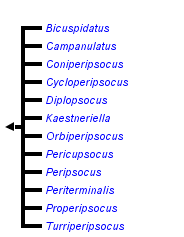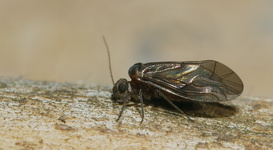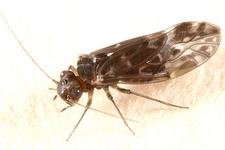Peripsocidae
Emilie Bess and Kevin P. Johnson


This tree diagram shows the relationships between several groups of organisms.
The root of the current tree connects the organisms featured in this tree to their containing group and the rest of the Tree of Life. The basal branching point in the tree represents the ancestor of the other groups in the tree. This ancestor diversified over time into several descendent subgroups, which are represented as internal nodes and terminal taxa to the right.

You can click on the root to travel down the Tree of Life all the way to the root of all Life, and you can click on the names of descendent subgroups to travel up the Tree of Life all the way to individual species.
For more information on ToL tree formatting, please see Interpreting the Tree or Classification. To learn more about phylogenetic trees, please visit our Phylogenetic Biology pages.
close boxIntroduction
The family Peripsocidae contains about 235 species in 12 genera distributed worldwide, with highest diversity in Asia. Thirteen species are known from North America in the genera Peripsocus and Kaestneriella.
Peripsocids are medium-sized bark lice (2-4 mm, nymphs 2-2.5 mm) with robust bodies. Body color is dusky brown. Peripsocids inhabit bark of trees and shrubs and rock surfaces. Some species are sexually dimporphic (different body forms in male and female) or polymorphic (different body forms within a sex).
Characteristics
Synapomorphy
- Forewing: Areola postica is absent.
- Male: Parameres of phallosome are fused posteriorly, with strap-like shape.
General Characters
- Head: Antennae have 13 segments.
- Legs: Tarsi have 2 segments.
- Wings:
- Wings are clear or with diffuse spots or bands.
- Adult wing length varies: full-length, short, or wingless.
- Forewing:
- Forewing veins fewer than in many bark lice:
- Areola postica is absent because vein Cu1A is absent.
- Veins Rs and M are usually fused for part of their length.
- Pterostigma has a curved hind margin.
- Forewings have no hairs or very few hairs on veins and wing margin.
- Hindwing:
- Hindwing veins Rs and M are fused for a distance.
- Hindwing is hairless.
- Male:
- Phallosome external parameres are fused posteriorly, with strap-like shape.
- Phallosome has complex sclerotisations on tip, usually symmetrical.
- Epiproct lacks ornamentation.
- Clunium often has prominent comb extending posteriorly.
- Female:
- Subgenital plate has a single posterior lobe.
- Gonapophyses are complete and well developed:
- Ventral valve is thick.
- Dorsal valve is well developed and hairy.
- External valve is hairy and varies in size.
- Eggs: Eggs are laid singly or in small groups, have a rough surface, and are covered with debris.
How to Know the Family
- Robust, medium-sized bark lice: 2-4 mm.
- Hairs on body and wings are sparse or absent.
- Tarsi have 2 segments.
- Adult wing length varies: full-length, short, or wingless.
- Forewing lacks areola postica.
Discussion of Phylogenetic Relationships
Monophyly of family Peripsocidae is well supported by two morphological characters: absence of the areola postica in the forewing and, in the male, a strap-like paramere on the phallosome (Yoshizawa 2002). Molecular data also support the monophyly of the family based on the sister relationship of genera Peripsocus and Kaestneriella (18S nDNA and 12S, 16S, COI mtDNA, Johnson & Mockford 2003; 18S nDNA, Johnson et al 2004), but relationships within the family have not been studied further with molecular techniques.References
Johnson, K. P. & E. L. Mockford. 2003. Molecular Systematics of Psocomorpha (Psocoptera). Systematic Entomology 28: 409-40.
Johnson, K. P., K. Yoshizawa, and V. S. Smith. 2004. Multiple origins of parasitism in lice. Proceedings of the Royal Society of London B 271:1771-1776.
Lienhard, C. and C. N Smithers. 2002. Psocoptera (Insecta) World Catalogue and Bibliography. Muséum d'Histoire Naturelle, Geneva, Switzerland.
Mockford, E. L. 1993. North American Psocoptera (Insecta). Gainesville, Florida: Sandhill Crane Press.
New, T.R. 2005. Psocids, Psocoptera (Booklice and barklice), 2nd edition: Handbooks for the Identification of British Insects. Vol. 1, Part 7. Royal Entomological Society, London, UK.
Smithers, C. N. 1996. Psocoptera. Pp. 1-80, 363-372 (Index) in Wells A. (ed.) Zoological Catalogue of Australia. Vol. 26. Psocoptera, Phthiraptera, Thysanoptera. Melbourne: CSIRO Publishing, Australia.
Yoshizawa, K. 2002. Phylogeny and higher classification of suborder Psocomorpha (Insecta: Psocodea:'Psocoptera'). Zoological Journal of the Linnean Society 136: 371-400.
Title Illustrations

| Scientific Name | Peripsocus sp. |
|---|---|
| Location | Japan |
| Specimen Condition | Live Specimen |
| Identified By | K. Yoshizawa |
| Life Cycle Stage | adult |
| View | lateral |
| Size | 3mm |
| Copyright | © 2006 Kazunori Yoshizawa |
| Scientific Name | Peripsocus |
|---|---|
| Location | Groton, Ma. |
| Comments | 10/3/2007 |
| Specimen Condition | Live Specimen |
| Life Cycle Stage | adult |
| View | lateral |
| Copyright | © Tom Murray |
About This Page
Emilie Bess

Illinois Natural History Survey, Champaign, Illinois, USA
Kevin P. Johnson

Illinois Natural History Survey, Champaign, Illinois, USA
Correspondence regarding this page should be directed to Emilie Bess at and Kevin P. Johnson at
Page copyright © 2009 Emilie Bess and Kevin P. Johnson
All Rights Reserved.
- First online 25 March 2009
- Content changed 25 March 2009
Citing this page:
Bess, Emilie and Kevin P. Johnson. 2009. Peripsocidae. Version 25 March 2009 (under construction). http://tolweb.org/Peripsocidae/14473/2009.03.25 in The Tree of Life Web Project, http://tolweb.org/









 Go to quick links
Go to quick search
Go to navigation for this section of the ToL site
Go to detailed links for the ToL site
Go to quick links
Go to quick search
Go to navigation for this section of the ToL site
Go to detailed links for the ToL site